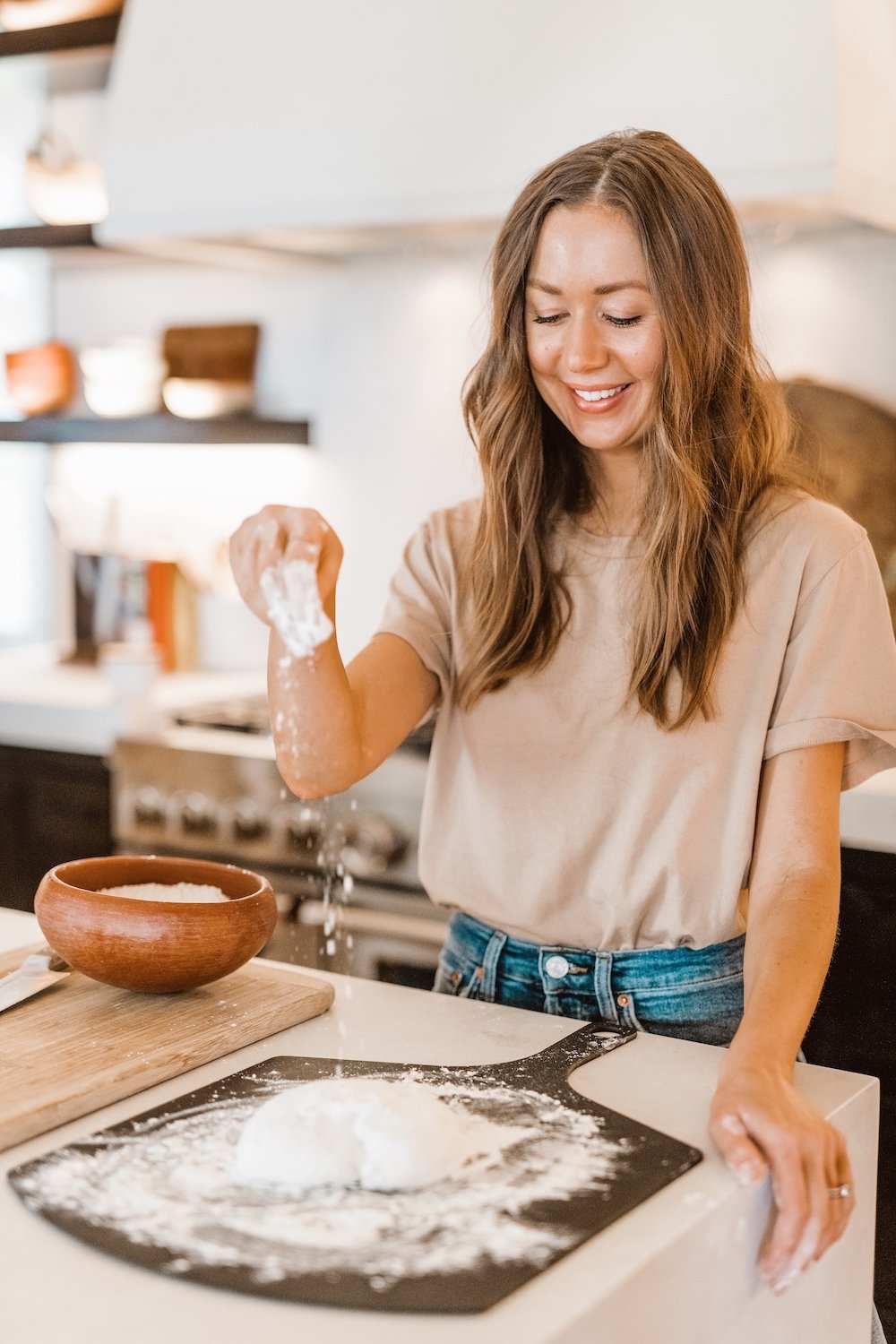If you’ve spent much time around here, you’ve probably picked up on the fact that I’m a pizza fanatic. Grilled or baked in the oven, homemade or takeout (my Austin faves are Home Slice and Swedish Hill)—I love them all. Don’t tell anyone, but I even like a thin crust pepperoni from Domino’s! But one thing I am very specific about is when I make it at home, it’s gotta be good. Enter, my easy homemade pizza dough recipe. I’ve made the same one for the past 10 years, with just a couple of small updates along the way.
The basic recipe is one I learned from Chef John Ash, based in Santa Rosa, California. In our first year of marriage, Adam surprised me by sending me to a weeklong “Culinary Bootcamp” at the CIA in Napa Valley. Not only was it a bucket list experience; Chef Ash was my teacher for the week, and one day in class, he showed us how to make homemade pizza dough along with his signature technique for grilling it. It resulted in some of the best pizza I’d ever had, and I’ve been making it ever since.
So, what makes this easy homemade pizza dough recipe the best?
For me, the perfect pizza crust is puffed-up with those wonderful little air bubbles—a charred, crispy exterior and chewy insides. This dough makes that kind of pizza.
The key is its simplicity: yeast, warm water, sugar, salt, flour, and olive oil—there’s a beauty in the basics of these ingredients. But with a little know-how, they become so much more than the sum of their parts. The only major change I’ve made to Chef Ash’s original recipe is the flour ratios. His pizza dough recipe called for all-purpose and cornmeal, but after getting inspired by my Gjelina cookbook (ie. my pizza bible), I started playing around with different flours and ratios. When I tried this one (half bread flour, half 00 flour), it was a major aha moment. I knew I’d found the one.
 What exactly is 00 Flour?
What exactly is 00 Flour?
Up until about a year ago, I’d heard about 00 flour from people who were “serious” about their pizza dough, but remained skeptical of whether it could actually make a difference… that is, until I used it myself. I could immediately feel the difference in the moisture and elasticity of the dough, and I could taste it, too. Quite simply, 00 flour is finely ground Italian flour. (In Europe, flours are categorized by how finely the flour has been ground, so 00 is at the “fine” end of the spectrum.) There are lots of different brands available, but this is the one that I use.
One major difference between “00” flour and all-purpose flour is how the gluten behaves. Since most “00” flour in the US is made from durum wheat, it tends to give that crispy exterior to our crust and when we combine with bread flour as I do here, we get that chewy on the inside quality we’re looking for. So, in my experience, the best flour for pizza dough is a combination of “00” flour and bread flour.
You can totally substitute all-purpose flour if you can’t get “00.” Since this is how I made my own pizza dough for the first nine years, I promise it’ll come out just fine.
How many pizzas does this recipe make?
This easy homemade pizza dough recipe makes enough for five 7-inch pizzas, four 9-inch pizzas, or three 10 to 12-inch pizzas, depending on how thinly you stretch them. Once you have your big ball of dough ready, shape it into a thick log shape, then use a knife coated in olive oil to divide it into even portions. If you’re not planning to use them all right away, drizzle your extra dough with olive oil, roll into a ball, and drop into a quart-sized freezer bag with as much air removed from the bag as possible. You can freeze this dough for up to 2 months, and let thaw in the fridge overnight.
How to Stretch Pizza Dough
The other major change I made to my technique is switching from rolling out pizza dough (with a rolling pin) to stretching it with my hands. I did this for a couple of reasons: for one, rolling the dough yields a pizza that’s flat on the edges while stretching it with your hands allows you to form that delicious, chewy crust around the edges. For another thing, my rolling technique would sometimes result in really bizarre-shaped pizzas. Nothing wrong with a rustic look, but I prefer the way that stretching allows me to create more perfectly round pizzas.
So, how do you stretch pizza dough? Rather than reinvent the (pizza) wheel, I let the experts be my guide. Here’s how the Gjelina cookbook describes the process:
“With your fingertips, punch the air out of the dough and press your fingers into the center and extend outward to shape the mass into a small disk. Continue to press your fingers and palm down on the center of the dough while turning with your other hand, pushing out the dough from the center but maintaining an airy rim around the perimeter. Continue stretching out the dough on the work surface with your hand by spreading your fingers as far as you can as you turn the dough… You are done stretching the dough when it is 10 to 12 inches in diameter and thin enough so that you can read a newspaper through it.”
Got that? I found it incredibly helpful to watch this Mario Batali video several times as I practiced. Don’t be afraid to use lots of flour, and remember, this technique takes some patience.
Pin the image above to your Pinterest board, then scroll on for the easy homemade pizza dough recipe I swear by. If you make it, be sure to tag us on Instagram and leave a rating and review!
My Easy Homemade Pizza Dough
Serves four 9-inch pizzas
For my easy homemade pizza dough recipe, I use a combination of "00" flour and bread flour to get that charred crispy crust that's chewy on the inside.
Prep
30 minutes
Categories
Ingredients
- 1 envelope (2.5 tsp) active dry yeast
- 2 cups warm water
- 2 tsp sugar
- 1 tbsp kosher salt
- 2 ½ cups 00 flour (I use this one)
- 2 ½ cups bread flour (I use this one)
- 3 tbsp olive oil, divided
Instructions
- In the bowl of an electric mixer fitted with the dough hook, stir yeast into warm water with sugar. Let it sit, undisturbed. After 5 minutes, you should see some bubbles form.
- Stir in salt & 1 tbsp of olive oil. Add both flours, a little at a time, stirring at low speed for about 4 minutes, until the dough forms a rough ball and pulls away from the sides of the mixing bowl. You may need to add a little more flour (if it's too sticky) or water (if it looks dry.) Let the dough rest in the bowl for 15 minutes. (It should still be fairly soft at this point.)
- Remove dough from bowl and divide into 4 pieces. (If you want bigger pizzas, divide into 3; if you want smaller pizzas, divide into 5.) Gently round each piece into ball and brush or rub with olive oil. Place each into a zippered plastic storage bag and drizzle remaining olive oil over each ball and seal bags closed. Let balls sit for at least 1 hour, or (even better) refrigerate them overnight. Sitting overnight gives the dough more flavor.
- If you’ve refrigerated your dough, it's very important that you take it out of the fridge for at least 1 hour before making pizzas. You can also freeze dough for up to 3 months. Plan ahead to let dough fully thaw and come to room temperature before stretching.
- To stretch the pizza dough, dust the dough, your hands, and your work surface liberally with flour. Press your fingers into the center of a dough ball and extend outward to shape it into a small disk. Continue to press your fingers and palm down on the center of the dough while turning with your other hand, pushing out the dough from the center but maintaining an airy rim around the perimeter. Add more flour if it starts to get sticky.
- You're done stretching the dough when it's thin in the middle and has a nice crust on the edges. Then, you're ready to proceed with any pizza recipe -- baked in the oven or tossed on the grill.











Converting that to grams (which most pizza makers prefer to work with) and figuring 600 grams of flour to 480 grams of water, it looks like 80% hydration.
Is that what you intended?
Hey Jorg! Not sure about the gram and percentage – I always measure this one in cups and it turns out perfectly with these measurements. You can double the recipe if you want to scale up!
Pizza Dough
What oven temp and how long ? Thank You
It does say 500? oven for 8 to 10 minutes. States this in the full recipe.
I made a batch, cooked one of them fresh that day and put the others in the freezer. I took one from the freezer to the fridge for a day and then let it warm up for an hour on the counter before cooking. It was still good but the texture was definitely different than the fresh one. How long would the dough keep in the fridge vs freezing it? We eat homemade pizza once a week.
Hi Kellie! The dough keeps for a week in the fridge, so you could definitely go that route with one of the dough balls as well, to save it for the following week. I agree that the texture is a little stronger when its fresh, but a couple things for freezer success:
1. Let the fresh dough sit in the fridge overnight, then squeeze any air out of your ziploc before popping it in the freezer.
2. The day you’re eating it, try letting it sit on the counter at room temp for even longer to make sure and eliminate all the chill from the dough–you definitely don’t want to try stretching it while it’s at all cold.
Good luck and report back! 🙂
Also curious on oven temperature and time?
Haven’t tried this recipe yet. I just got my type OO flour and so excited to try using it! Wondering why only using half type OO flour (could I use all type OO)? Also could I use self-rising flour for the other half? Most homemade recipes say to let rise for 4-5 hours ..is that just not necessary because one hour is much more convenient! Last question.. what does the olive oil do for the dough?
What temperature to cook the pizza and how long?
As high as you can get it – I like to use my pizza oven and get it up to 600 – 700 degrees. In an at-home oven, crank it up to 500, and pull it out when the cheese is melted and the crust is crispy on the bottom.
Can I make it today and use it on Wednesday? So that’s 3 1/2 days in fridge?